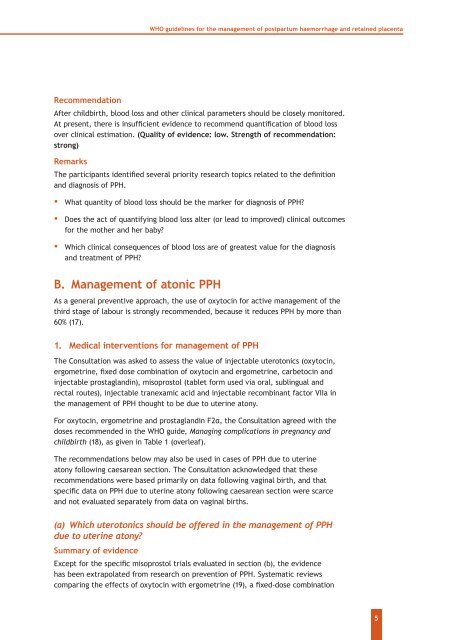WHO guidelines for the management of postpartum haemorrhage ...
WHO guidelines for the management of postpartum haemorrhage ...
WHO guidelines for the management of postpartum haemorrhage ...
Create successful ePaper yourself
Turn your PDF publications into a flip-book with our unique Google optimized e-Paper software.
<strong>WHO</strong> <strong>guidelines</strong> <strong>for</strong> <strong>the</strong> <strong>management</strong> <strong>of</strong> <strong>postpartum</strong> <strong>haemorrhage</strong> and retained placenta<br />
Recommendation<br />
After childbirth, blood loss and o<strong>the</strong>r clinical parameters should be closely monitored.<br />
At present, <strong>the</strong>re is insufficient evidence to recommend quantification <strong>of</strong> blood loss<br />
over clinical estimation. (Quality <strong>of</strong> evidence: low. Strength <strong>of</strong> recommendation:<br />
strong)<br />
Remarks<br />
The participants identified several priority research topics related to <strong>the</strong> definition<br />
and diagnosis <strong>of</strong> PPH.<br />
▪ What quantity <strong>of</strong> blood loss should be <strong>the</strong> marker <strong>for</strong> diagnosis <strong>of</strong> PPH?<br />
▪ Does <strong>the</strong> act <strong>of</strong> quantifying blood loss alter (or lead to improved) clinical outcomes<br />
<strong>for</strong> <strong>the</strong> mo<strong>the</strong>r and her baby?<br />
▪ Which clinical consequences <strong>of</strong> blood loss are <strong>of</strong> greatest value <strong>for</strong> <strong>the</strong> diagnosis<br />
and treatment <strong>of</strong> PPH?<br />
B. Management <strong>of</strong> atonic PPH<br />
As a general preventive approach, <strong>the</strong> use <strong>of</strong> oxytocin <strong>for</strong> active <strong>management</strong> <strong>of</strong> <strong>the</strong><br />
third stage <strong>of</strong> labour is strongly recommended, because it reduces PPH by more than<br />
60% (17).<br />
1. Medical interventions <strong>for</strong> <strong>management</strong> <strong>of</strong> PPH<br />
The Consultation was asked to assess <strong>the</strong> value <strong>of</strong> injectable uterotonics (oxytocin,<br />
ergometrine, fixed dose combination <strong>of</strong> oxytocin and ergometrine, carbetocin and<br />
injectable prostaglandin), misoprostol (tablet <strong>for</strong>m used via oral, sublingual and<br />
rectal routes), injectable tranexamic acid and injectable recombinant factor VIIa in<br />
<strong>the</strong> <strong>management</strong> <strong>of</strong> PPH thought to be due to uterine atony.<br />
For oxytocin, ergometrine and prostaglandin F2α, <strong>the</strong> Consultation agreed with <strong>the</strong><br />
doses recommended in <strong>the</strong> <strong>WHO</strong> guide, Managing complications in pregnancy and<br />
childbirth (18), as given in Table 1 (overleaf).<br />
The recommendations below may also be used in cases <strong>of</strong> PPH due to uterine<br />
atony following caesarean section. The Consultation acknowledged that <strong>the</strong>se<br />
recommendations were based primarily on data following vaginal birth, and that<br />
specific data on PPH due to uterine atony following caesarean section were scarce<br />
and not evaluated separately from data on vaginal births.<br />
(a) Which uterotonics should be <strong>of</strong>fered in <strong>the</strong> <strong>management</strong> <strong>of</strong> PPH<br />
due to uterine atony?<br />
Summary <strong>of</strong> evidence<br />
Except <strong>for</strong> <strong>the</strong> specific misoprostol trials evaluated in section (b), <strong>the</strong> evidence<br />
has been extrapolated from research on prevention <strong>of</strong> PPH. Systematic reviews<br />
comparing <strong>the</strong> effects <strong>of</strong> oxytocin with ergometrine (19), a fixed-dose combination<br />
5
















